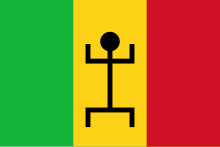Mali flag
The Mali flag was adopted on March 1, 1961.
On January 20, 1961, four months after the proclamation of the independence of the Republic of Mali, on September 22, 1960, the deputies gathered in plenary session in the National Assembly adopted law no. 61-62 that created the national flag.
Presentation of the flag
The law of January 20, 1961 established the definitive version of the Mali flag, with the three bands of green, gold and red.
The green color of the first band means hope, the greenness of the country's meadows and fields, its land and everything that can be produced for the well-being of the population. The green reminds the vocation of shepherds of the country and the development, in the modernization that it contains and the integration of the efforts.
The second vertical band is gold in color, which refers to the country's subsoil and other potential mineral resources. The gold color testifies to the awareness that the people of Mali have about their heritage and that it is necessary to defend it.
The red color of the third band is a reminder and an exhortation. Malians must remember the blood spilled to defend the country from foreign occupation and liberation from colonial yoke. The red of the national flag is an exhortation for the population to fight until the last drop of water to preserve the integrity of the country, the soil and the subsoil, the artistic and cultural patrimony until they are exploited only for their own interest.
Previous flag
The flag of Mali closely resembles that of the Federation of Mali, which bears on the gold band a symbol representing a kanaga mask, a cultural element of the Dogon people. The current Mali considers itself as the heir of that State. Briefly, the Federation flag was the flag of Mali, but the image on the mask was removed under pressure from Muslims, who did not want human-shaped images.
Contenido relacionado
Delhi
Kochi Prefecture
Santa Colomba de Somoza
